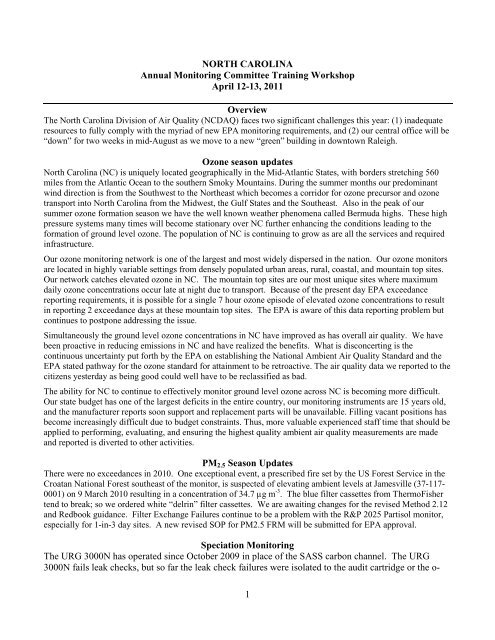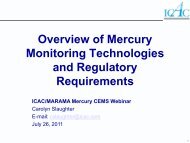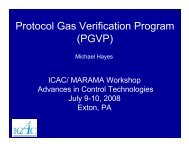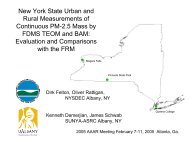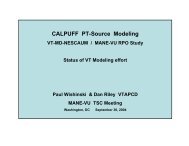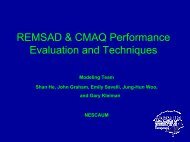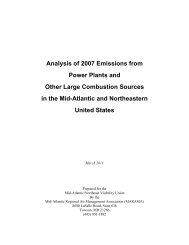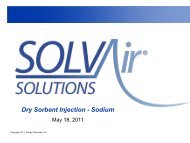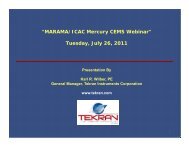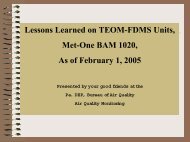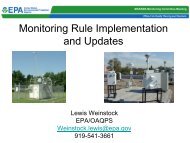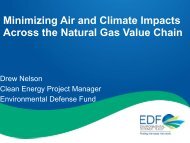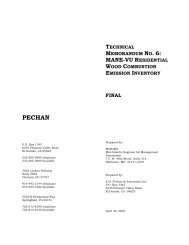North Carolina - MARAMA | Mid-Atlantic Regional Air Management ...
North Carolina - MARAMA | Mid-Atlantic Regional Air Management ...
North Carolina - MARAMA | Mid-Atlantic Regional Air Management ...
- No tags were found...
You also want an ePaper? Increase the reach of your titles
YUMPU automatically turns print PDFs into web optimized ePapers that Google loves.
NORTH CAROLINAAnnual Monitoring Committee Training WorkshopApril 12-13, 2011OverviewThe <strong>North</strong> <strong>Carolina</strong> Division of <strong>Air</strong> Quality (NCDAQ) faces two significant challenges this year: (1) inadequateresources to fully comply with the myriad of new EPA monitoring requirements, and (2) our central office will be“down” for two weeks in mid-August as we move to a new “green” building in downtown Raleigh.Ozone season updates<strong>North</strong> <strong>Carolina</strong> (NC) is uniquely located geographically in the <strong>Mid</strong>-<strong>Atlantic</strong> States, with borders stretching 560miles from the <strong>Atlantic</strong> Ocean to the southern Smoky Mountains. During the summer months our predominantwind direction is from the Southwest to the <strong>North</strong>east which becomes a corridor for ozone precursor and ozonetransport into <strong>North</strong> <strong>Carolina</strong> from the <strong>Mid</strong>west, the Gulf States and the Southeast. Also in the peak of oursummer ozone formation season we have the well known weather phenomena called Bermuda highs. These highpressure systems many times will become stationary over NC further enhancing the conditions leading to theformation of ground level ozone. The population of NC is continuing to grow as are all the services and requiredinfrastructure.Our ozone monitoring network is one of the largest and most widely dispersed in the nation. Our ozone monitorsare located in highly variable settings from densely populated urban areas, rural, coastal, and mountain top sites.Our network catches elevated ozone in NC. The mountain top sites are our most unique sites where maximumdaily ozone concentrations occur late at night due to transport. Because of the present day EPA exceedancereporting requirements, it is possible for a single 7 hour ozone episode of elevated ozone concentrations to resultin reporting 2 exceedance days at these mountain top sites. The EPA is aware of this data reporting problem butcontinues to postpone addressing the issue.Simultaneously the ground level ozone concentrations in NC have improved as has overall air quality. We havebeen proactive in reducing emissions in NC and have realized the benefits. What is disconcerting is thecontinuous uncertainty put forth by the EPA on establishing the National Ambient <strong>Air</strong> Quality Standard and theEPA stated pathway for the ozone standard for attainment to be retroactive. The air quality data we reported to thecitizens yesterday as being good could well have to be reclassified as bad.The ability for NC to continue to effectively monitor ground level ozone across NC is becoming more difficult.Our state budget has one of the largest deficits in the entire country, our monitoring instruments are 15 years old,and the manufacturer reports soon support and replacement parts will be unavailable. Filling vacant positions hasbecome increasingly difficult due to budget constraints. Thus, more valuable experienced staff time that should beapplied to performing, evaluating, and ensuring the highest quality ambient air quality measurements are madeand reported is diverted to other activities.PM 2.5 Season UpdatesThere were no exceedances in 2010. One exceptional event, a prescribed fire set by the US Forest Service in theCroatan National Forest southeast of the monitor, is suspected of elevating ambient levels at Jamesville (37-117-0001) on 9 March 2010 resulting in a concentration of 34.7 µg m -3 . The blue filter cassettes from ThermoFishertend to break; so we ordered white “delrin” filter cassettes. We are awaiting changes for the revised Method 2.12and Redbook guidance. Filter Exchange Failures continue to be a problem with the R&P 2025 Partisol monitor,especially for 1-in-3 day sites. A new revised SOP for PM2.5 FRM will be submitted for EPA approval.Speciation MonitoringThe URG 3000N has operated since October 2009 in place of the SASS carbon channel. The URG3000N fails leak checks, but so far the leak check failures were isolated to the audit cartridge or the o-1
ings in the cyclone. URG developed 2-yr maintenance kits and a set of instructions to send with thekits. The flow rate audits and verifications can now be uploaded to AQS via RTI’s audit repository asrequired per 40 CFR 58.16. In our annual monitoring workshop, URG made an excellent presentationon the 2-yr training, showing how to perform the 2-yr maintenance procedures on the URG 3000N. TheMet ONE SASS monitors show their age, but seem to operate fairly well. EPA should develop a 1-daycertification course where auditors can get certified without having the full-training.NCore Level 2 SitesThe NC DAQ NCore monitoring site has been operational since mid year 2010 and was officiallydesignated as such on January 1, 2011 as required by the EPA. The site selected for the NCore locationwas the existing Millbrook SLAMS site. Specifics for this site are provided below:ParameterDescriptionA) AQS identification number 37-183-0014B) Site Name MillbrookC) Address 3801 Spring Forest Road, Raleigh, N.C.D) Longitude/Latitude W 078 34’ 27”/N 35 51’ 22”E) Scale of Representation Neighborhood/Population OrientedF) Proximity to Local Emissions None within 500 metersG) MSA Description Urban-Raleigh/Durham/Chapel HillThis NCore site currently has the following monitors in place and fully operational: 1) Trace Level (TL)Sulfur Dioxide; 2) TL Carbon Monoxide; 3) TL Reactive oxides of Nitrogen with 10 meter high inlet; 4)Ozone; 5) PM 2.5 (fine PM), continuous and primary (BAM); 6) PM 2.5 , filter based collocated with BAM(1 in 3); 7) Speciated PM 2.5, filter based; 8) PM 10 , filter based low volume sampler; 9) PM 10-2.5 (coursePM), by difference, PM 10 -PM 2.5 ; and 10) meteorological measurements of wind speed and direction,relative humidity and ambient temperature.Supplemental activities also required by the EPA that have been completed include: 1) certification ofclean air generators; 2) Method Detection Limit (MDL) studies for trace level monitors; and 3)preparation, submittal and approval of QAP/SOPs for all activities associated with the operation of theNCore site.Toxics MonitoringNC DAQ Toxics Protection Branch (TPB) operates a network of 6 urban air toxics sites statewide inAshville, Winston-Salem, Charlotte, Montgomery County (reference background site in Piedmont area),Raleigh, and Wilmington. The Durham-RTP site was closed by EPA due to road construction in late2008. These sites use the TO-15 method for VOCs. Collection of samples for TO-11 method forcarbonyls was discontinued. NC DAQ samples core compounds, federal hazardous air pollutants andstate-regulated toxic air compounds. NC DAQ samples 3 of the 6 EPA NATTS Year 1 compounds -Benzene, 1-3 Butadiene and Acrolein. We do not sample Arsenic, Chrome VI or Formaldehyde becausethe NC DAQ does not have the resources to handle the sampling and analysis for them. Samplescollected by DAQ, and sent to RTI, are analyzed for Arsenic under a federal contract. Parts have beenordered and a separate method developed to lower the MDL for Acrolein. NC DAQ samples 7 of the 14EPA NATTS “must” compounds. The NC DAQ <strong>Air</strong> Toxics Branch does hotspot monitoring at facilitiesthat result in penalties.2
<strong>Air</strong> Toxics GrantsNC DAQ, TPB has not received an air toxics grant in the past 5 years.Network Design IssuesThe NCDAQ is currently designing a Population-Weighted-Emission-Inventory (PWEI) SO 2 networkfor NC. Five new monitors are needed to meet PWEI requirements. The NCDAQ is also identifyingpotential locations for near road NO 2 monitors. The near-road Raleigh-Cary and Durham-Chapel Hillmonitors will be within five miles of each other. Thus, the NCDAQ will request a waiver for theRaleigh-Cary near road NO 2 monitor. The NCDAQ is also preparing lead waiver requests for facilitiesreporting over a half ton of lead emissions in 2009. For military bases, the NCDAQ will use screeningmodeling with conservative inputs to demonstrate concentrations off of the base are less than half thestandard. For 2010-2011 all carbonyl samplers were removed.The EPA requested that NCDAQ relocate its collocated FRMs to sites with higher PM 2.5concentrations. As a result, the NCDAQ relocated the collocated monitor at the Millbrook monitoringsite in Raleigh to the Rockwell monitoring site. The EPA also requested that the NCDAQ not changethe AQS ID for an ozone monitor that moved across the street. The NCDAQ decided to change theAQS ID because the address of the monitor changed and AQS has no good way of handling these typesof changes. The EPA also requested that the network plan and AQS agree on assigned monitor types.Annual Monitoring ReportsThe last completed report is for 2006. The 2007 report is expected to be complete by May or June 2011,and the 2008 report 5 or 6 months after that. It is too expensive to print them nowadays, so we publishthem online (http://daq.state.nc.us/monitor/reports/) and use email (“spam”) to notify our distributionlist. Our electronic formatted reports are also available from the State Library of <strong>North</strong> <strong>Carolina</strong> DigitalRepository http://statelibrary.ncdcr.gov/patrons/stategovernment.html > Digital Information<strong>Management</strong> Program. The TPB prepares an Annual <strong>Air</strong> Toxics Report covering only the air toxicsmonitoring in NC. The 2009 Annual <strong>Air</strong> Toxics Report is available on the web site athttp://daq.state.nc.us/toxics/risk/AATR.shtml.Monitoring LabsIn the Particle Monitoring (PM) Lab the ongoing challenge is to maintain the Lab at the propertemperature and relative humidity. So far we have been able to do that and weigh all filters in a timelymanner, processing well over 5000 filters with minimal errors and on-schedule within the time allowedby the Mobley rule for weighing filters. The lab also supplied logistical support for make-ups for filterexchange failures as well as normal samples. In August we will be moving the PM laboratory to a newbuilding. Another challenge is the change in the PM2.5 FRM filter supplier to MTL. We changed thecalibration standard weights (using 200 mg and 500 mg) for the balance verification to accommodate theheavier weight of new MTL filter’s rings.Staffing LevelsThe Ambient Monitoring Section (AMS) lost two positions and the TPB lost 4 positions which are notanticipated to be restored. The TPB and AMS have submitted requests for two and one intern,respectively, for data systems work for the 2011 summer internship period and hope to fill thosepositions.3
NC Ambient Monitoring and Toxic Protection Staff –RCOName Duties Phone EmailDonnie Redmond Section Chief – Ambient Monitoring 919-733-1487 Donnie.Redmond@ncdenr.govElaine Byrd AMS Administrative Assistant 919-715-0665 Elaine.Byrd@ncdenr.govFrank Stellitano Supervisor - Electronics & Calibration Branch 919-715-1761 Frank.Stellitano@ncdenr.govKim Gold ECB Administrative Assistant 919-715-1761 Kim.Gold@ncdenr.govChristian Burge Certification of Calibrators, NO y/ HSCO maintenance andperformance audits 919-715-1761 Christian.Burge@ncdenr.govDerrick House O 3 Equipment Maint. & Performance Audits 919-715-1761 Derrick.House@ncdenr.govJohnny Doctor SO 2, Reactive oxides of Nitrogen, Ammonia, CO &continuous speciation monitoring919-715-1761 Johnny.Doctor@ncdenr.govFrank Corduan Manual Fine Particle Monitor Maintenance 919-715-1761 Frank.Corduan@ncdenr.govJames Olcott Ozone Equipment Maint. & Performance Audits 919-715-1761 James.Olcott@ncdenr.govJerry Godwin Meteorological and Continuous PM 919-715-1761 Jerry.Godwin@ncdenr.govJames Stroup NO y / HSCO maintenance and audits 919-715-1761 James.Stroup@ncdenr.govJohn Gittings Certification of Equipment, PM 10 & TSP Maintenance 919-715-1761 John.Gittings@ncdenr.govMark Yirka SO 2, Reactive oxides of Nitrogen, Ammonia, CO &continuous speciation monitoring 919-715-1761 Mark.Yirka@ncdenr.govRoger Locklear Meteorological and Continuous PM 919-715-1761 Roger.Locklear@ncdenr.govWade Daniel Ozone certifications, monitoring 919-715-1761 Wade.Daniel@ncdenr.govWayne CorneliusSupervisor - Data Mgmt and Statistical ServicesBranch919-715-3460 Wayne.Cornelius@ncdenr.govKaren Harris Data management, telemetry data processing 919-715-0660 Karen.Harris@ncdenr.govKellie Hales Data management, noncont. data processing 919 715-6318 Kellie.Hales@ncdenr.govVitaly Karpusenko Statistical data analysis 919-715-6275 Vitaly.Karpusenko@ncdenr.govTahmina Islam Research Assist, data reports 919-715-6701 Tahmina.Islam@ncdenr.govLucyna Kozek Research Assist, data reports 919-715-9561 Lucyna.Kozek@ncdenr.govJoette Steger Supervisor - Projects & Procedures Branch 919-715-0762 Joette.Steger@ncdenr.govJ P Chauhan 2.5 FRM questions & Lab head 919-715-8666 JP.Chuahan@ncdenr.govCharles Davis Ammonia, Ozone QA - Cont. Monitoring 919-715-1874 Charles.O.Davis@ncdenr.govJim McGaughey SO 2 , Cont. 2.5, Sulfate 919-715-7961 Jim.McGaughey@ncdenr.govFrances Stallings Particle Lab 919-733-2056 Frances.Stallings@ncdenr.govMary Clark Particle Lab 919-715-6273 Mary.Clark@ncdenr.govPhyllis Lowry Hydrocarbon (HC) Lab 919-715-0891 Phyllis.B.Lowry@ncdenr.govCarlton Blakley HC Lab, CO, Cont. Carbon, NO Y & Nitrate 919-715-0662 Carlton.Blakley@ncdenr.govLori Cherry Supervisor – Toxics Protection Branch 919-733-1476 Lori.Cherry@ncdenr.govJim Bowyer Toxics Laboratory Manager 919-715-7484 Jim.Bowyer@ncdenr.govJohn Holland Toxics QA and Reporting Lead 919-715-7747 John.Holland@ncdenr.govU.S. Mail to any staff can be addressed to: DENR/Div. of <strong>Air</strong> Quality, 1641 MSC, Raleigh, NC 276994


